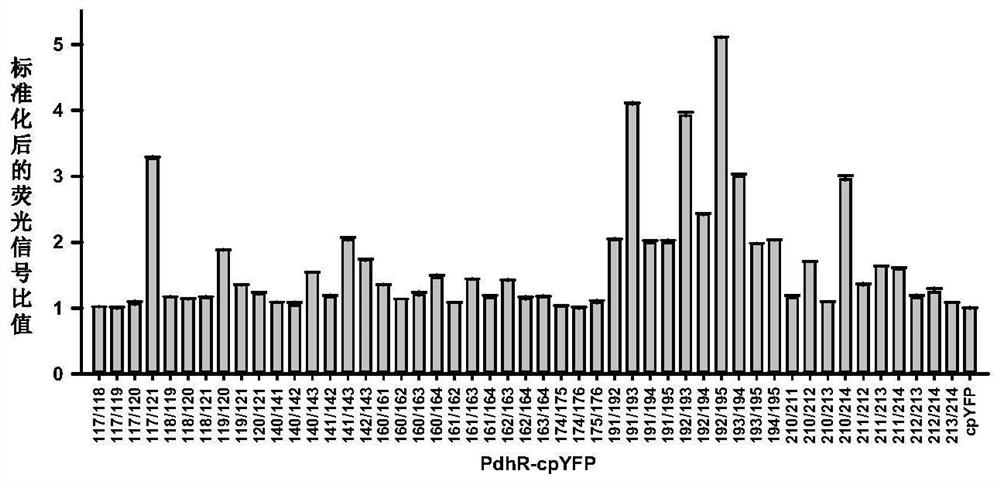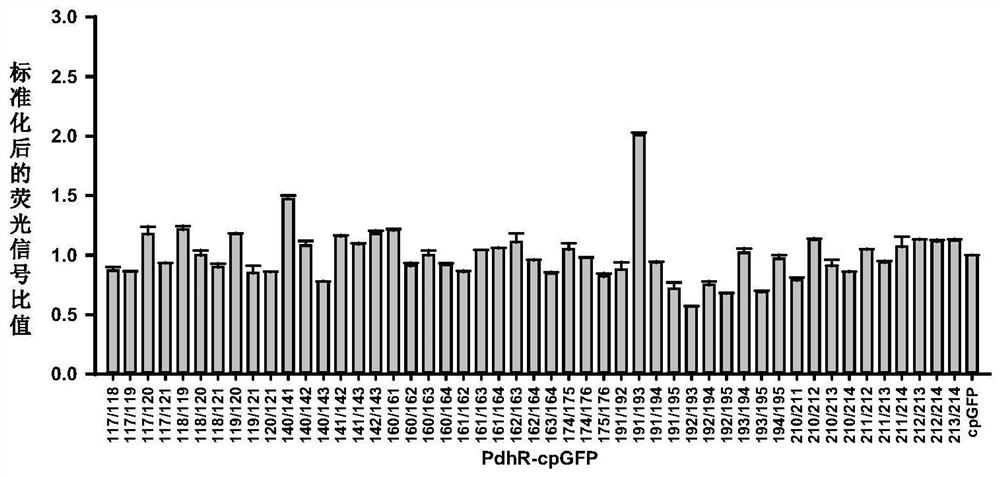Pyruvate optical probe as well as preparation method and application thereof
An optical probe, pyruvate technology, applied in the field of optical probes, can solve the problem of in situ, real-time, dynamic, high-throughput and high-space-time resolution detection, cell fragmentation, separation, extraction and purification, not suitable for living cell research, etc. problems, to achieve the effect of large dynamic changes in fluorescence, easy maturation, and elimination of sample processing steps
- Summary
- Abstract
- Description
- Claims
- Application Information
AI Technical Summary
Problems solved by technology
Method used
Image
Examples
Embodiment approach
[0062]In an exemplary embodiment, the B1-A-B2 type optical probe of the present invention can be selected from 117 / 121, 141 / 143, 191 / 192, 191 / 193, 191 / 194, 191 of PdhR (96-254) One or more sites of / 195, 192 / 193, 192 / 194, 192 / 195, 193 / 194, 193 / 195, 194 / 195, 210 / 214 are inserted with cpYFP and have one or more selected from the following Mutant probes: Q138P, Q138L, R191Y, R191F, R191L, R191P, E193Q, E193L, M194D, M194V, M194H, M194W, M194V and S190E and R191N and R192D (M194V / S190E / R191N / R190D and M1902D), R191Y and R192T (M194V / S190D / R191Y / R192T), S190P and R191H and R192P (S190P / R191H / R192P), S190R and R191S and R192P (S190R / R191S / R192P), S190L and R191V / R190L) (S190L) (S190L) R191Q and R192E (S190T / R191Q / R192E) or R191S and R192T (R191S / R192T). Preferably, the optical probe is a probe with cpYFP inserted at the 191 / 193 site of PdhR(96-254) and having Q138P, Q138L, R191Y, R191F, R191L, R191P, E193Q or E193L mutations, or a probe of PdhR(96-254) -254) with cpYFP inserted at...
Embodiment 1
[0121] Example 1: Pyruvate-binding protein particles
[0122] The PdhR (96-254) gene in the Escherichia coli gene was amplified by PCR, and the PCR product was recovered after gel electrophoresis and digested with BamHI and HindIII, and the pCDFDuet1 vector was subjected to corresponding double digestion. After ligation with T4 DNA ligase, the product was transformed into MachI, and the transformed MachI was spread on LB plates (streptomycin sulfate 50ug / mL) and incubated overnight at 37°C. After plasmid extraction of the growing MachI transformants, PCR identification was performed. After the positive plasmid is correctly sequenced, the subsequent plasmid construction is carried out.
Embodiment 2
[0123] Example 2: Expression and detection of cpYFP optical probes at different insertion sites
[0124] In this example, based on pCDFDuet-PdhR(96-254), the following site was selected to insert cpYFP according to the crystal structure of pyruvate-binding protein, and the corresponding pCDFDuet-PdhR(96-254)-cpYFP plasmid was obtained: 117 / 118, 117 / 119, 117 / 120, 117 / 121, 118 / 119, 118 / 120, 118 / 121, 119 / 120, 119 / 121, 120 / 121, 140 / 141, 140 / 142, 140 / 143, 141 / 142, 141 / 143, 142 / 143, 160 / 161, 160 / 162, 160 / 163, 160 / 164, 161 / 162, 161 / 163, 161 / 164, 162 / 163, 162 / 164, 163 / 164, 174 / 175, 174 / 176, 175 / 176, 191 / 192, 191 / 193, 191 / 194, 191 / 195, 192 / 193, 192 / 194, 192 / 195, 193 / 194, 193 / 195, 194 / 195, 210 / 211, 210 / 212, 210 / 213, 210 / 214, 211 / 212, 211 / 213, 211 / 214, 212 / 213, 212 / 214 or 213 / 214. Exemplary sequences are shown in Table 1.
[0125] Table 1. Sequences of Optical Probes
[0126] sequence insertion site SEQ ID NO:6 117 / 121 SEQ ID NO:7 141 / 143 SEQ ID NO:8 1...
PUM
 Login to View More
Login to View More Abstract
Description
Claims
Application Information
 Login to View More
Login to View More - R&D
- Intellectual Property
- Life Sciences
- Materials
- Tech Scout
- Unparalleled Data Quality
- Higher Quality Content
- 60% Fewer Hallucinations
Browse by: Latest US Patents, China's latest patents, Technical Efficacy Thesaurus, Application Domain, Technology Topic, Popular Technical Reports.
© 2025 PatSnap. All rights reserved.Legal|Privacy policy|Modern Slavery Act Transparency Statement|Sitemap|About US| Contact US: help@patsnap.com



